Any content marketer will tell you that a content program is a long-term play, and may not yield immediate results. And while it’s important to be patient, you must also periodically check your results to see whether your strategy is on the right track.
So, it's time for us to report on how well our content program is doing.
But we can't just include a long list of numbers on how every blog post is doing—what's the most important thing our CMO needs to know?
We need to pick some KPIs...
The metrics that are important enough to be tracked and reported on weekly and monthly are your content marketing key performance indicators (KPIs).
Anything you track but don’t report on frequently is simply a metric.
The most important thing to remember is that your content marketing KPIs must match the goals you identified when building your content marketing strategy.
Hence if your organization’s goals are to create more visibility for the brand, focusing on sales attributed to content marketing may not be your highest priority KPI, unlike other teams that are laser-focused on that goal.
In this post, we’ll take a deeper dive into content KPIs suitable at different stages of the buyer journey including brand awareness, audience development, lead generation, and sales.
Content Marketing KPIs for Brand Awareness
Funnel Stage: Top of Funnel
Goals: Reach new audience members & prospective customers
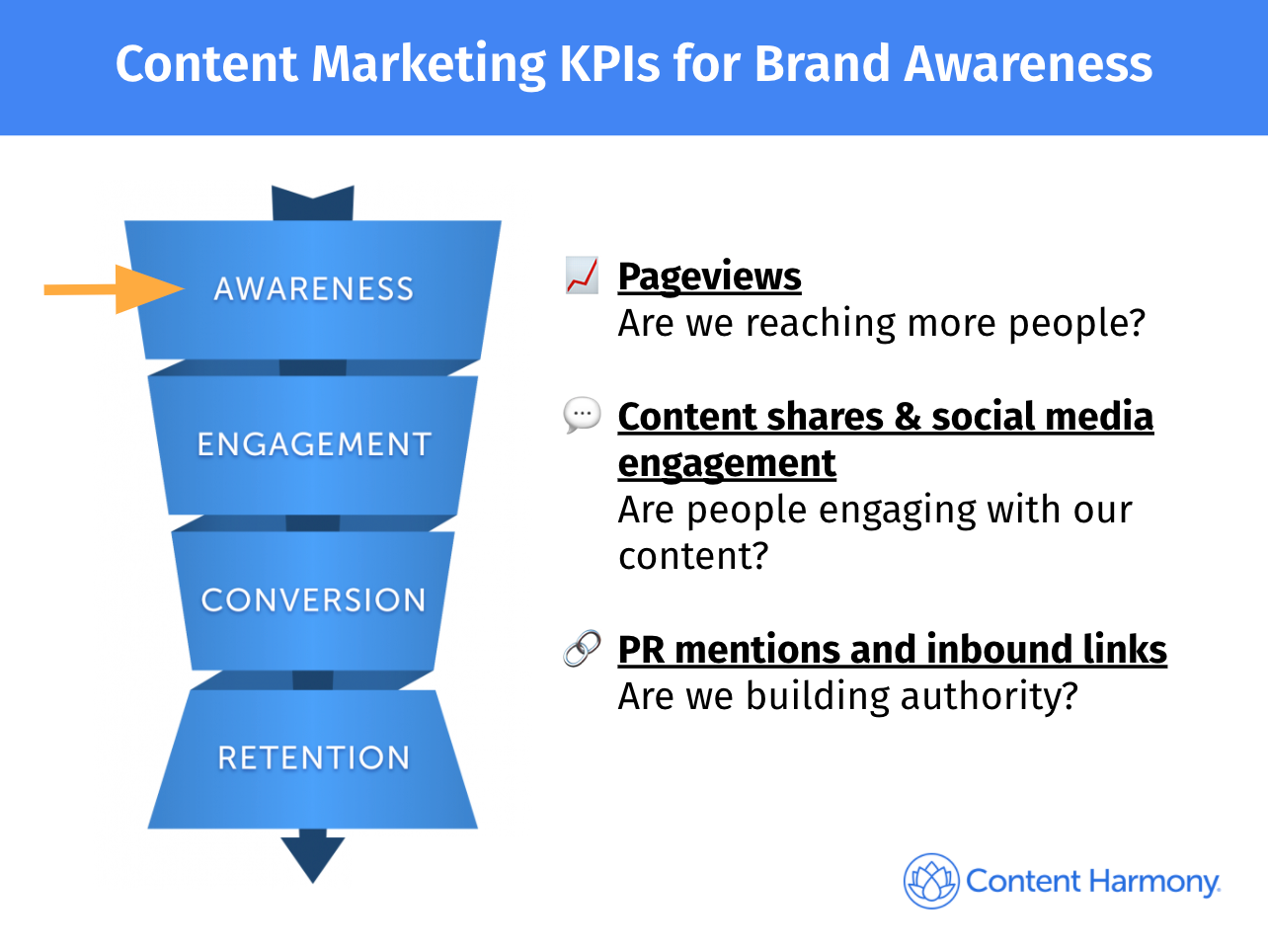
Brand awareness KPIs are focused on expanding the reach of your brand to its target audience — so that more people get to know it, trust it, and ultimately transact with it.
Brand awareness campaigns will not result in revenue immediately, but they’re instrumental in making the marketplace know you exist. The more your brand stands out in channels where your audience consumes content, the easier it is for them to recognize you when they’re in a purchase cycle.
Additionally, brand awareness metrics tend to be the easiest metrics to track, so there are multiple potential content marketing KPIs that will tell you whether you’re succeeding in growing brand awareness.
📈 Pageviews
An overall increase in traffic to your content marketing assets, measured by page views, is the simplest metric for how many people are seeing your content. It’s easy to segment by channel to see where those visitors are coming from, and it’s easy to paint a picture of overall growth across all content marketing efforts.
However, page views can also be seen as a vanity metric of sorts since they don’t tell you whether the right kind of audience lands on your site. For example, if you’re doing content marketing for an audience of eCommerce marketers, then ideally you would like to reach people who work in eCommerce. But if your content is too broad and pulling in non-eCommerce professionals as well, that’s still counted as a page view even if they’re not the audience you need to be reaching.
Nonetheless, an increase in page views shows that the visibility of your brand is growing and it’s reaching more people. That’s an important content marketing KPI for most content marketing programs.
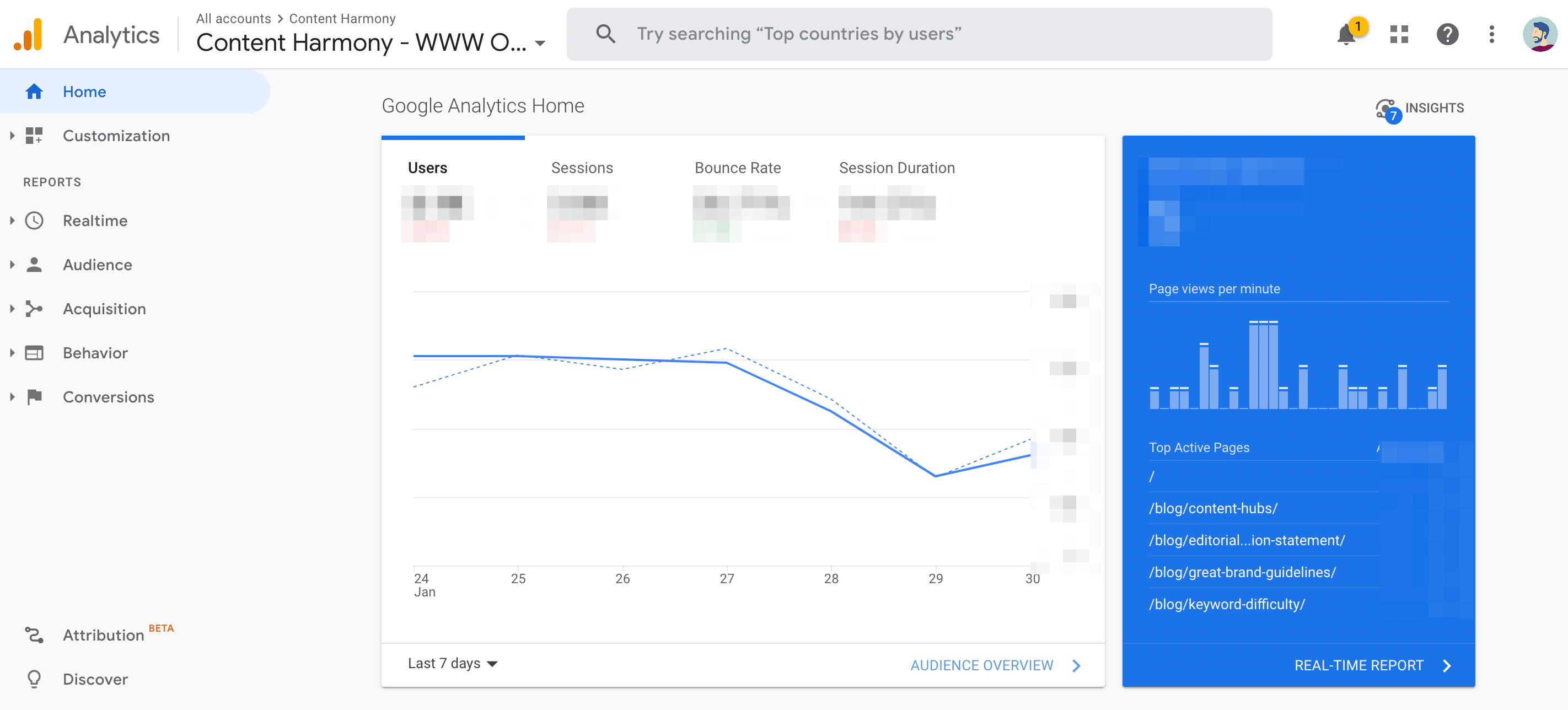
💬 Content shares & social media engagement
Another way of checking whether your content is reaching more people, and resonating with prospects is if they start to share your content organically. Not all content marketing programs drive high social engagement, but if you see users organically sharing your content, that’s a strong signal that what you’re publishing is reaching the right people.
This also extends to engagement with the content you’re sharing directly on your own social channels. If you’re growing the rate at which your audience clicks shared links, comments, and re-shares, that’s also a strong signal when tracked over time.
Organic engagement is a telling sign that your content is having the desired effect: it’s sparking conversations, educating prospects, and providing value to your audience.
🔗 PR mentions and inbound links
Well-researched and authoritative content is cited by other websites and publications, so if you see an increase in organic links and mentions, that’s another sign you’re hitting the mark with your content strategy.
For teams trying to aggressively build their authority and organic traffic, this can sometimes be the #1 top of funnel KPI for a content program.
Even for teams not actively doing outreach and PR for their content, this is an important metric to track. If your content is not attracting these types of links organically, it leaves the market open to competitors who *are* building links actively to outrank your brand for those topics.
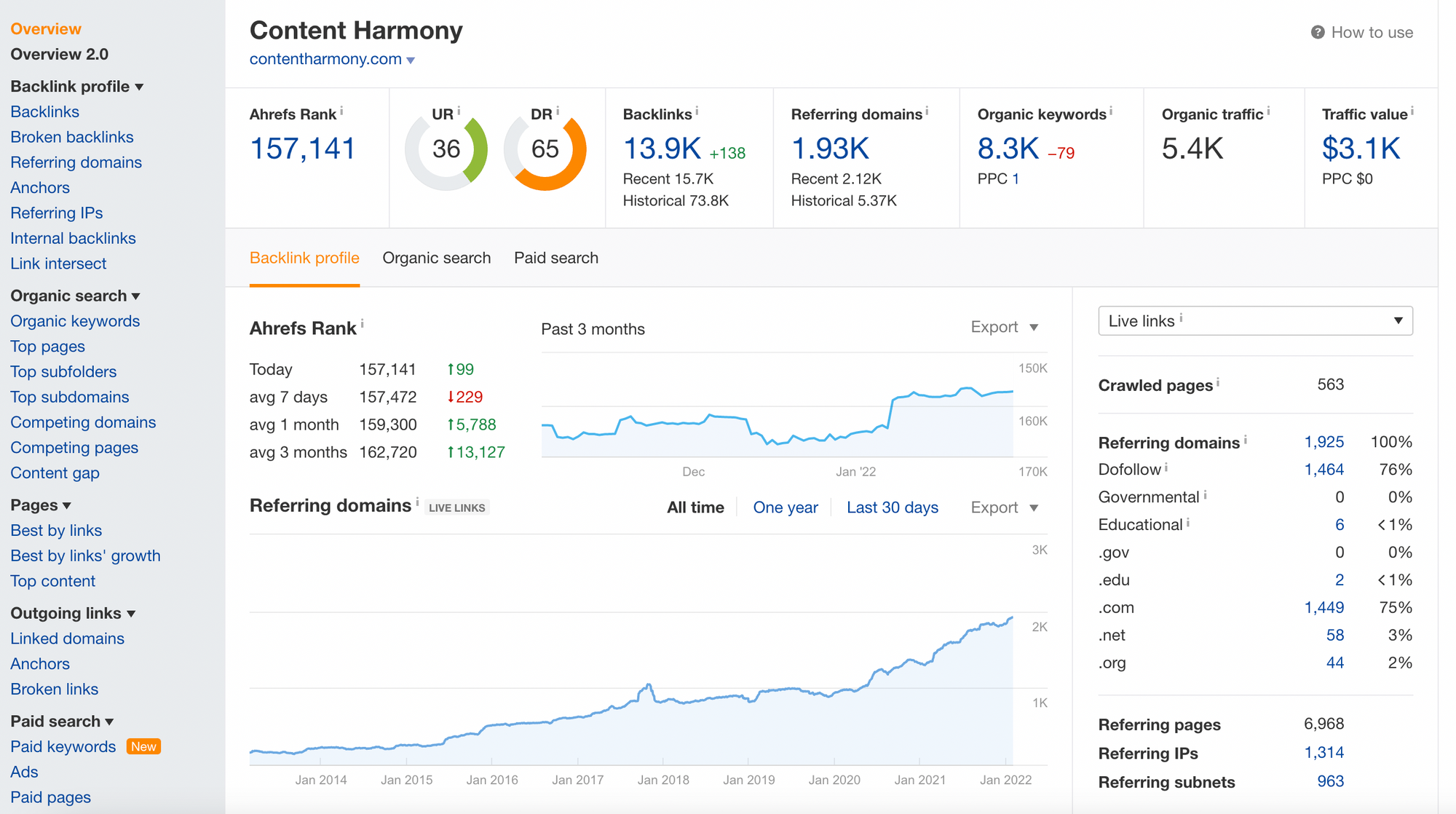
Content Marketing KPIs for Engagement
Funnel Stage: Middle of Funnel
Goals: Audience Development & Consideration
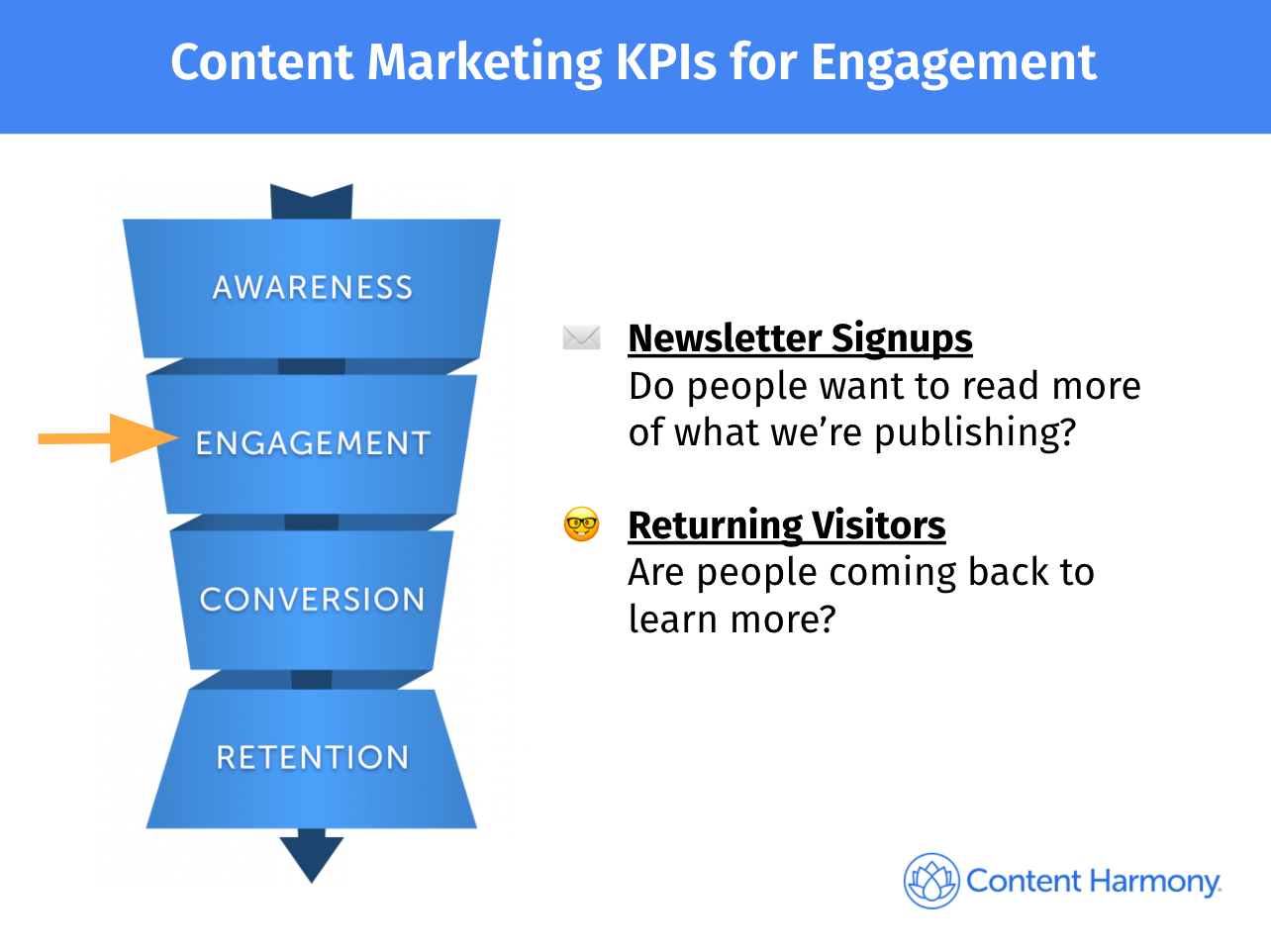
Your content has successfully managed to reach more people, but are they willing to enter a long-term relationship? If your content isn’t good enough to keep people coming back for more, it’s probably not leaving a great brand impression in the first place.
Here are a few KPIs that demonstrate this:
️✉️ Newsletter Signups
If someone’s handing over their email address to subscribe to your newsletter, that’s a sign that they’ve started to trust your brand. They want to keep in touch and hear what you have to say. Email is also a highly effective sales channel, so if you’re witnessing healthy growth in your subscriber list, that’s a sure shot sign that your content program is working.
These will typically be tracked in Google Analytics via Goal Conversion when user fills out an email form or gets redirected to a "Thank You" page.
🤓 Returning Visitors
Tracking new organic visitors is great for brand building and awareness campaigns, but what percentage of visitors are actively returning to your site to consume more content or learn more about what you’re selling?
If your content is persuading folks to move down the funnel, then you should witness a greater percentage of returning visitors. Ideally, you’ll see these visitors checking out lower-funnel pages critical in researching a sales decision, such as your pricing page, “About Us” page, social proof, case studies, etc.
To track the percentage of returning vs new visitors, navigate over to Google Analytics > Audience > Behavior > New vs Returning. Here you’re able to add more filters such as time ranges and demographic data.
Other approaches include tracking multi-touch attribution against Google Analytics Goals for form submissions and visits to certain Content Groups. For example, “we saw 1300 people this month who visited a key purchase page after landing on a blog post.”
Content Marketing KPIs for Lead Generation & Sales
Funnel Stage: Bottom of Funnel
Goals: Increase quality and volume of leads and sales
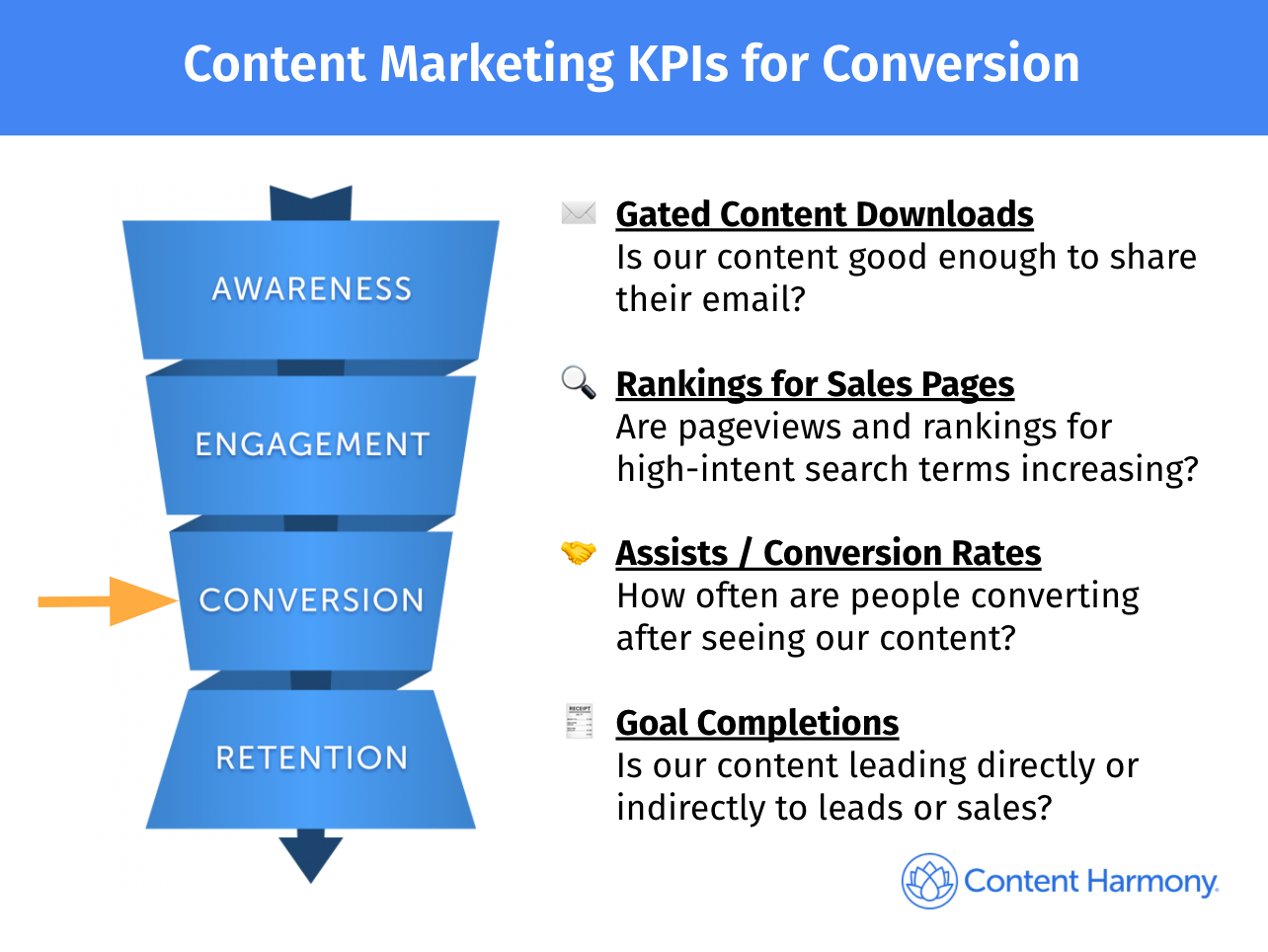
Content plays a critical role in encouraging folks to move down the funnel. As such, there are many content marketing KPIs that can tell you whether your marketing efforts are having a positive impact on demand generation efforts and if you’re contributing to the sales pipeline.
Here are a few of them:
📩 Gated Content Downloads
You’ve probably come across eBooks or whitepapers that are only accessible if you hand over some qualifying details, such as an email address. This is an example of how content marketing plays a role with lead generation campaigns — the assumption being that someone downloading the asset is, at least, a “marketing qualified lead” since they’re intrigued and want to learn more.
We won’t get into the classic gated vs ungated marketing debate at this point, but if your strategy includes using gated content to acquire more leads, then the sheer number of downloads should tell you whether that’s working or not.
Note: these types of leads are often early to classify as “bottom of funnel” so you may need to distinguish between earlier funnel content assets like whitepapers, and lower funnel stage assets like case studies or buyer’s guides.
🔍 Rankings for Key Landing Pages
If you’re thinking that SEO rankings are a top of the funnel type of metric, you’re usually right.
But SEO rankings will play a role across the entire customer lifecycle, and tracking rankings and pageviews for the pages that drive the most revenue can be an important content marketing performance metric if content marketing efforts are driving those improvements.
Content-heavy examples of such pages include comparison pages, buyer’s guides, competitor alternative pages, or sales-driven assets like case studies.
Growth in traffic is potentially a more clear metric to track here, however, rankings for critical search queries can be important as well, even if they are lower volume. A good standard to measure here is whether your team has built content that is ranking for critical Adwords search terms.
🤝 Revenue & Conversion Rates
Whether or not content marketing will drive directly attributable conversions depends heavily on your business model, your industry, and the type of content you’re investing in.
But that said, it’s obviously the holy grail of content marketing performance that many stakeholders want to see.
There are many businesses that are lucky enough to have direct conversion opportunities from content, especially when that content is part of the purchase research process.
For example, if you’re able to rank organically for high intent queries that convert well, that could result in a steady stream of revenue directly attributable to content marketing.
If that’s not the case for your organization, you can still track multi-touch attribution against your other revenue-producing conversions, whether that’s a lead form completion, a literal shopping cart completion, or user signup.
👨💻 Replacement Value of Traffic
While it’s not quite as good as direct attribution of sales, showing the replacement value of the traffic you’re generating is a decent bottom-of-funnel KPI to track.
We're not referring to sitewide traffic values from tools like Ahrefs and Semrush - in this case, we’re talking about demonstrating traffic from known conversion keywords that your paid marketing team is literally spending money to advertise on.
Let’s say you work in content marketing for AVG Antivirus and one of the ways your PPC team is getting folks to buy your software is via campaigns for the keyword “antivirus for mac”. While there will always be competitors bidding for this keyword, the fact is that customers are much more likely to trust organic results over paid.
If your content marketing team builds content that can start to rank organically for this keyword and track those clicks through Google Search Console, it’s reasonable for your team to take direct credits for the value the PPC team would have spent to produce the same clicks.
So if your PPC team spends $15k per month on that exact keyword at $8 average cost-per-click, and your page is driving 600 organic clicks per month on that phrase, it’s reasonable for you to take credit for $4,800 in value created for the business that month, even though you won’t have the same level of sales attribution that the PPC team has access to.
Naturally, there are lots of caveats to these types of calculations, and you may not be able to use the same high CPC for every keyword that the page happens to be ranking for, but in aggregate what we want is to show a big number that is much higher than the cost of your content marketing program overall.
Here’s a good post from Clay Cazier on how to calculate organic traffic value across a large keyword set. If you have your own internal Adwords data, defer to that instead, since it will be more representative of what the keyword is worth to your company.
🧾 Goal Completions
If you’re managing enterprise products that have sales cycles that can last months or an offline service such as pest control, the ROI of your content marketing efforts can be judged based on specific actions you wish your customers to take.
While these actions may not result in revenue immediately, they’re still valuable steps across the buyer journey. For example, you may want a prospect to book a demo with a sales representative or for someone to pick up the phone and call your business. Your content, of course, must be valuable, compelling, and relevant enough to encourage prospects to do so.
Goal completions can be set up in Google Analytics, enabling you to track which pages or events accomplished that goal.
Content Marketing KPIs for Retention
Funnel Stage: Post Funnel
Goals: Keep customers happy & repurchasing
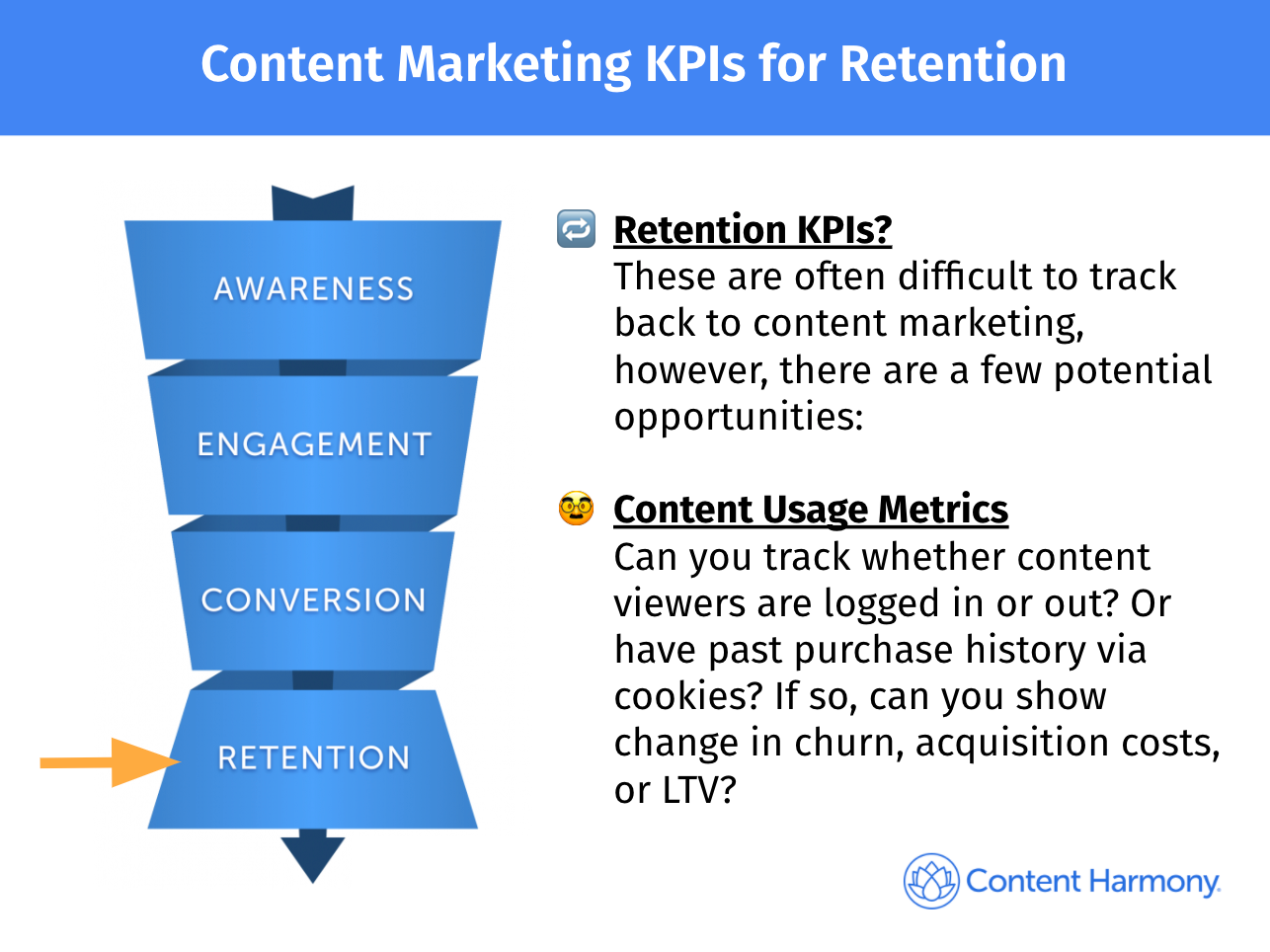
Most content programs focus on customer acquisition, but less so for user success and retention.
Customer retention strategies are valuable because they boost LTV, reduce churn, and improve the odds of word-of-mouth acquisition. We highly recommend that you use content marketing for customer retention, and we've outlined a few ways to do that in our post.
To measure the success of your retention strategies, you can start by tracking:
🔁 Churn Rate
Reducing churn rate cannot be the sole domain of a content program, since there are product considerations that determine whether users stick around or not.
Nonetheless, your content can play a role in effective user onboarding and success, which helps them get up to speed quickly and transform the product into a 'must-have'.
Product-focused content includes guides, tutorials, and videos on how to make the most out of the product you just signed up for.
At Content Harmony, for example, our onboarding includes an email sequence designed to explain each facet of the service and convert curious folks into power users:

Another example of using content marketing for retention is self-serve helpdesk content. The easier it is for users to find answers for common problems, the greater the likelihood that they'll stick around. But try reporting that in a single metric every month. ¯\_(ツ)_/¯
🥸 Content Usage By Current Customers
Are you able to track whether existing users logged in to your app are reading your content?
Or determine which readers have a past purchase history through cookies?
If that's the case, you're able to make a reasonable assumption that your content program is increasing the stickiness of both your product and your brand, since readers are engaging with it well after they entered their credit card details.
When paying customers continue to engage with your content, there should be a positive correlation with churn, LTV, and CAC. Not only are they using your product — it's possible that they're forwarding your newsletter to friends or recommending the latest blog post to their peers. They're sticking around for more and encouraging others to become part of the tribe.
Common Content Marketing Metrics That *Should NOT* Be KPIs
The very definition of a KPI is something that indicates overall performance. It’s the type of number that your CEO or CMO wants to see in a slide deck each quarter.
If you browse around generic marketing blogs, you’ll see the following metrics listed as KPIs simply because they show up in Google Analytics.
That’s stupid.
Please do NOT report these types of metrics to people outside of the content marketing and SEO team because it will indicate that you probably aren’t focused on the goals they care about.
📲 Scroll Depth
You might witness an uptick in the sheer number of people visiting your content, but are they reading all the way to the end? If your content is boring, dry, or insipid, it might cause people to close the tab a quarter of the way through.
But - use that data to inform whether you should improve the content or not. It’s not something you need to report on outside of your team.
🚨 Bounce Rate
This one has been rehashed plenty over the years, but like scroll depth, it’s only useful within the context of a given page.
Lowering or raising the bounce rate is not a goal that aligns with what your organization cares about. In many cases, a higher bounce rate is simply an indicator that users liked your content and got an answer to their query.
Long story short - tracking bounce rate across your content in aggregate is almost useless, and not a true KPI.
⏰ Time on Page
Time on page tells you the amount of time that folks spent on your page, usually measured in seconds.
It will not tell you that they spent 20 seconds on the page because they loved what they read and jumped over to the pricing page.
It also won’t tell you that they spent 20 minutes on your blog post because they couldn’t easily find an answer to what they were searching for.
Much like bounce rate and scroll depth, tracking this metric in aggregate is the wrong way to use it, and stakeholders do not care about it.
Want to see how Content Harmony helps you build content that outranks the competition?
The blog post you just read scores Good in our Content Grader for the topic "content marketing kpis".
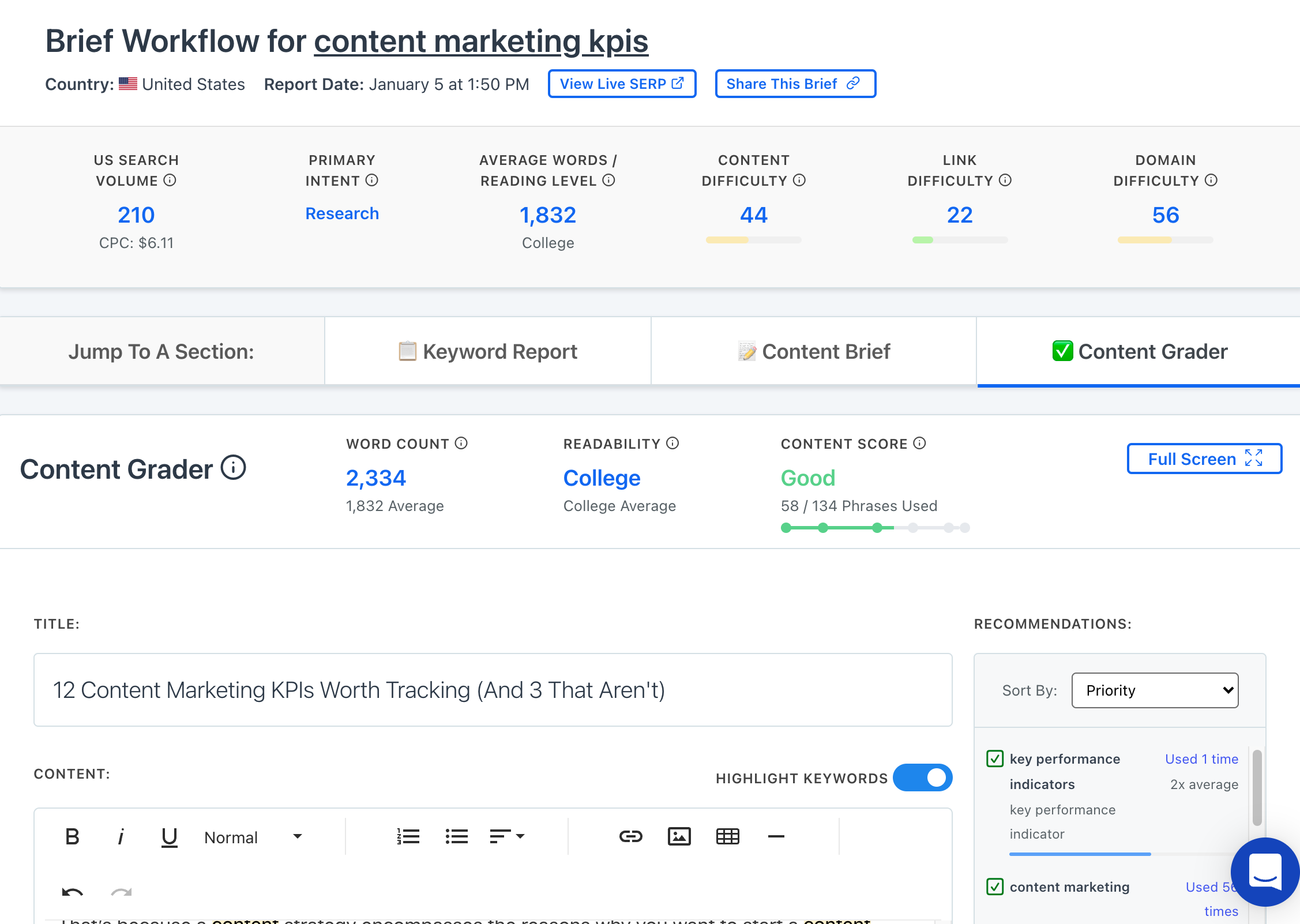
Grade your content against an AI-driven topic model using Content Harmony - get your first 10 credits for free when you schedule a demo, or sign up here to take it for a spin on your own.
👉 Get Your First 10 Briefs For $10
✉️ Get an email when we publish new content:
Don't worry, we won't bug you with junk. Just great content marketing resources.
Ready To Try
Content Harmony?
Get your first 10 briefs for just $10
No trial limits or auto renewals. Just upgrade when you're ready.

You Might Also Like:
- The Wile E. Coyote Approach To Content Guidelines
- Content Brief Templates: 20 Free Downloads & Examples
- The Keyword Difficulty Myth
- How To Find Bottom of Funnel (BoFU) Keywords That Convert
- Bottom of Funnel Content: What Is BOFU Content & 10 Great Examples
- 20 Content Refresh Case Studies & Examples: How Updating Content Can Lead to a Tidal Wave of Traffic 🌊
- How to Create Editorial Guidelines [With 9+ Examples]
- Content Marketing Roles
- How To Write SEO-Focused Content Briefs
- The Content Optimization Framework: [Intent > Topic > UX]
- How To Update & Refresh Old Website Content (And Why)
- 16 Best Content Writing Tools in 2024 (Free & Paid)
- How to Create a Content Marketing Strategy [+ Free Template]
- How To Create Content Marketing Proposals That Land The Best Clients
- What Is A Content Brief (And Why Is It Important)?
- How To Create A Dynamite Editorial Calendar [+ Free Spreadsheet Template]
- How to Use Content Marketing to Improve Customer Retention
- Types of Content Hubs: 5 Approaches & 30+ Examples
- How To Do A Content Marketing Quick Wins Analysis
- There's A Better Way To Measure Keyword Difficulty

